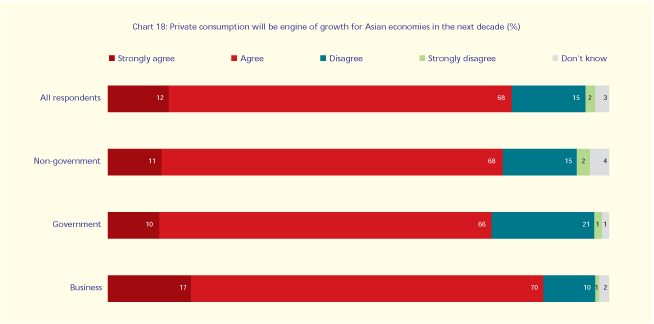Regional Challenges
Beyond the economic and financial risks that cloud the near-term outlook, there are many medium and longer-term challenges facing the Asia Pacific region. It is beyond the scope of this report to list those challenges, which include economic, environmental, social, political, and demographic factors.
Medium and Longer Term Challenges
The focus of this section is on medium and longerterm challenges that were identified in the survey of opinion-leaders and which have a transpacific dimension, including the possibility of cooperative actions to address these issues in an Asia Pacific context. Three themes stand out: the growing concern over environmental challenges and energy security; the stalled Doha trade round and its consequences; and the continuing risk of persistent transpacific imbalances.
Environment and energy security
Environment and energy security have become top concerns in the Asia Pacific region, particularly as leaders increasingly make the link between sustainability and long-term growth.
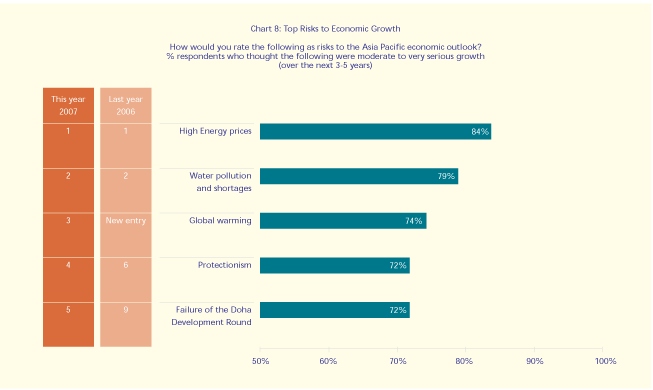
Ten Years after the Asian Crisis
The sharpest and most sudden downturn in East Asian economic growth occurred in 1997- 98 when short-term capital flooded away from the region, causing significant hardship in Thailand, Indonesia, Malaysia, the Philippines, and South Korea. A decade later, the region is widely perceived to be much better equipped to fend off a similar financial crisis. Among opinion leaders in the region surveyed by PECC, 76 percent agree that East Asian economies today are “less vulnerable to a regional economic downturn along the lines of the 1997-98 financial crisis” than they were a decade ago.
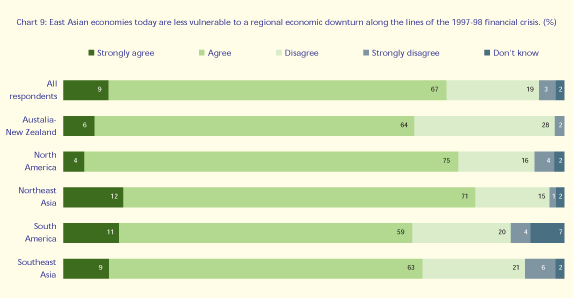
Since 1997, Asian economies have largely avoided the unholy combination of fixed exchange rates, high levels of short-term external debt, low interest rates, and poor corporate governance that made them vulnerable to bubbles and speculative attacks. On the other hand, investment in many Asian economies has not returned to the levels achieved in the 1990s, and increasing reliance on export-oriented growth is creating imbalances in global trade that have contributed to tensions in the system.
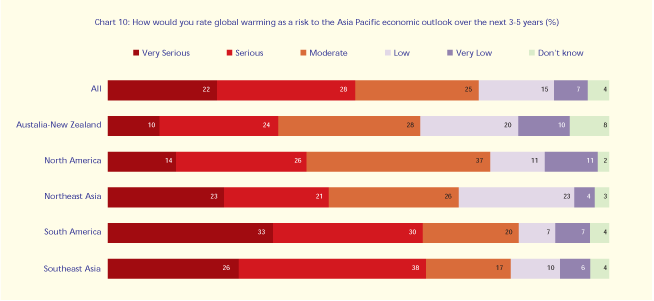
Responding to these growing concerns, APEC Leaders in Sydney issued a Declaration on Climate Change, Energy Security and Clean Development. This statement includes a non-binding commitment on the part of APEC members to reduce energy intensity by 25 percent by 2030, increase forest cover in APEC economies by at least 20 million hectares by 2020, and to establish Asia Pacific networks on sustainable forest management and rehabilitation, and energy technology.
The Declaration is a response to the UN Framework Convention on Climate Change (the United Nations body which oversees the Kyoto Protocol), which has created standing demand for regional positions on the environment issue, and adds momentum to the UNFCCC’s Bali meeting at the end of 2007. The EU promotes the Kyoto Protocol as the core element of an international approach to climate change, but some industrialized Asia Pacific economies — especially the United States and more recently Canada — are not convinced that Kyoto is the best vehicle. The Howard administration in Australia was staunchly opposed to Kyoto, but under the newly-elected Labor government, Canberra is expected to ratify the agreement.
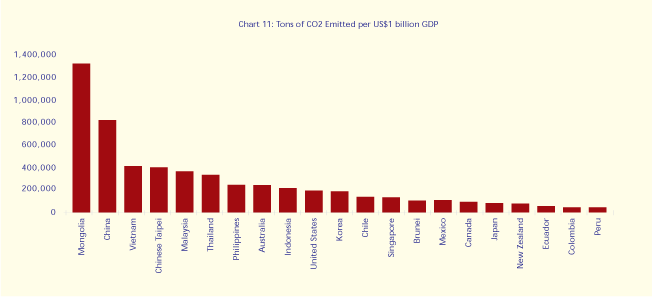
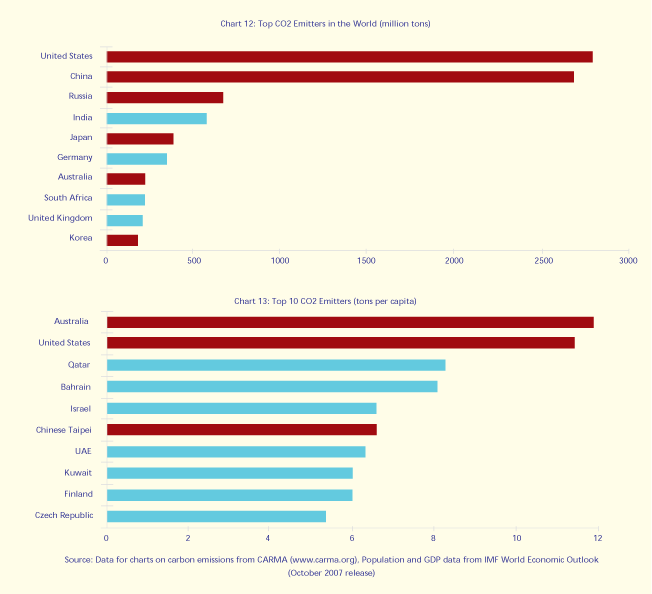
APEC’s “aspirational goals” on energy efficiency and increasing forest cover are a novel approach to climate change. They fail to address the core principle of Kyoto, however, which is to reduce the global level of carbon emissions rather than just the intensity of energy use. The success of this approach will very much depend on whether APEC is able to keep climate change high on the agenda, and to mobilize concrete collective action. The Asia Pacific economies bear a heavy responsibility since they account for approximately 64 percent of global carbon emissions. Australia has the highest per capita level of emissions, while the United States has the highest emissions overall, followed closely by China.
Energy security has gained salience in the international scene for a number of reasons, chief among them worries over the connection between the use of fossil fuels and climate change, commercial rivalry and conflict in areas where oil deposits are located, and indications that some suppliers are prepared to use their control of energy flows as a political instrument. Popular discussion about the physical limits to supply of conventional energy sources has also shaped political reactions to questions of energy security.
Environmental challenges are more diffuse. They include issues such as illegal and unregulated exploitation of natural resources, the availability and management of fresh water supplies, health consequences of economic development, and others. Like energy security, many of these issues can only be effectively addressed at the global or broad regional levels, but there is clearly a role for parallel and coordinated efforts by Asia Pacific economies, as well as for the exchange of information and best practices among members of a regional grouping such as APEC.
Looking to the future, the evolving Asia Pacific agenda on these issues will likely include both Kyoto and non-Kyoto based approaches, including the use of targets, tradable permits, investments in low-carbon energy infrastructure, and technology transfer.
To achieve the needed alignment between national and international objectives, developing countries will have to be active participants in the negotiations, and better mechanisms for technology transfer from developed countries to developing countries will have to be explored. Technology will also play a crucial role in areas such as renewable energy development and carbon sequestration and capture, which permits the more sustainable use of the abundant coal resources in many Asia Pacific economies.
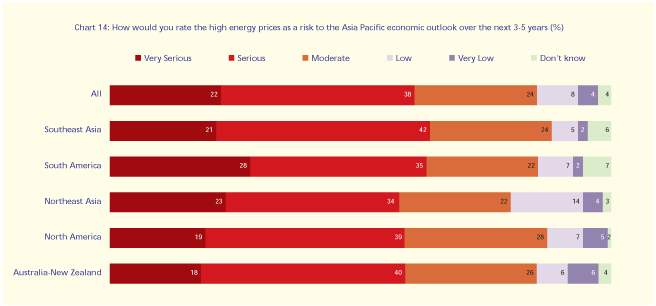
It is far from clear whether these issues will eventually be addressed in a mostly transpacific context, in sub-regions, or at the global level. At present, APEC has tried to confine itself to traderelated areas — the comparative advantage of APEC officials and networks being in the economic sphere. The East Asian Summit (EAS) and the ASEAN Plus Three have adopted a wider approach to regional issues modeled on information sharing, mutual understanding and the common pursuit of agreed objectives. The recent EAS meeting in Singapore has called on its 16 country membership to actively take part in forging a new environmental blueprint to replace the Kyoto Protocol, which expires in 2012.
Transpacific cooperation should have a special role to play on the environment issue. An adequate international response to greenhouse gas emissions requires agreement among both developed countries and developing countries. The ratification of Kyoto was unacceptable to policymakers in Washington not only because of the perception of economic hardship for the United States, but also because the agreement exempted major developing economies, especially China and India. At the same time, the international community generally agrees that there has to be recognition in any future agreement of the damage already done to the environment by countries that went through the dirtiest phases of industrialization before the global effects on the climate were understood.
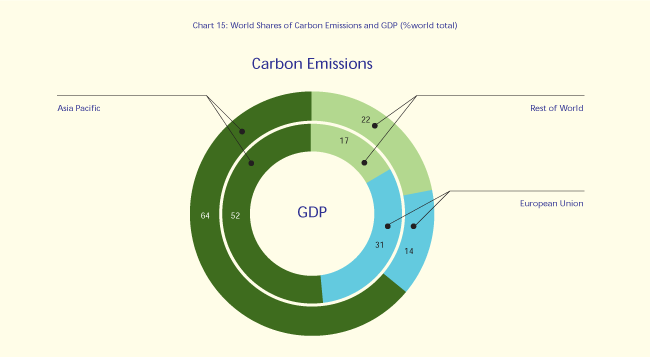
It is becoming clear that international policy must balance short-term assurances about the cost of prevention against the need for long-term assurances that greenhouse gas emissions will be capped. It is likely that future environmental cooperation will take the form of a set of cocoordinated pacts rather than a single binding agreement such as Kyoto.
APEC is well placed to make advances on all these fronts, precisely because it has a diverse membership that spans developed and developing economies, and encompasses a wide range of energy interests.
Some of the most important players in any future global regime for combating climate change happen to be APEC members. APEC also has the institutional experience of regional cooperation through voluntary measures and peer review mechanisms that are likely to form some aspect of a realistic post-Kyoto regime. However, APEC will need to demonstrate continuing political will to address these issues if it is to have a significant impact on the global effort to reduce greenhouse gases.
The WTO and its Alternatives
Despite repeated “last ditch” efforts on the part of the US, EU, India, and Brazil, the Doha Development Round appears to be no closer to completion at the end of 2007, more than a year after its scheduled completion date. Moreover, the US President’s Trade Promotion Authority (TPA) expired at the end of June of this year, and there appears to be almost no possibility of US congressional support for any negotiated trade deal in an election year. Agreements negotiated prior to expiration of TPA, namely with South Korea and Peru, will be considered under this authority and have significant prospects of passage.
When PECC asked about top priorities for APEC leaders to address prior to the Sydney meeting, the Doha Round was the top choice for survey respondents, followed closely by the establishment of a Free Trade Agreement of the Asia Pacific (FTAAP). Business respondents, as opposed to those from government or non-government, put the FTAAP as the highest priority.

There continues to be intense debate among trade policy specialists about the costs and benefits of preferential trade agreements such as the FTAAP, and their compatibility with multilateral trade liberalization. The survey suggests, however, that opinion leaders view preferential agreements as contributing to broader Asia Pacific economic integration. More than 70 percent of respondents agreed with the statement that “On balance, bilateral free trade agreements promote, rather than hinder, the integration of Asia Pacific economies.” For a strong majority of opinion leaders, there appears to be no contradiction between support for the WTO and support for preferential trade agreements. Whatever the outcome of Doha, bilateral trade agreements will likely remain a persistent feature of Asia Pacific trade relations.
APEC leaders at the 2007 Sydney meeting instructed officials to take forward the FTAAP idea, but did not provide details on how and when such an agreement might be forged. A 2006 study by PECC and the APEC Business Advisory Council (ABAC) points to a number of practical difficulties, not least of which are the multiple bilateral and regional trade agreements currently under consideration by APEC members, including a number of configurations that include only “Asian” economies.
Governments are aware of the dangers of multiple, overlapping trade agreements undercutting support for a global trade round and resulting in complex, overlapping rules of origin. Ongoing work within APEC to develop model measures for trade agreements, chapter-by-chapter, may serve to encourage higher quality preferential agreements and to minimize the negative effects of such agreements.
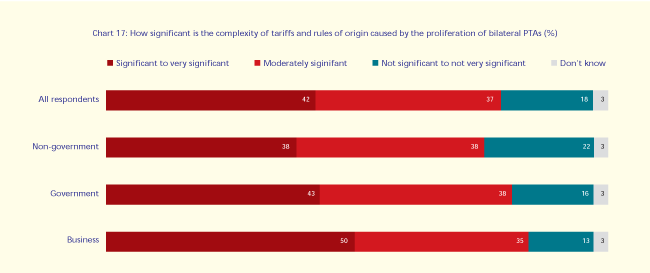
APEC has so far developed model measures for only 9 of 16 “typical” chapters and needs to step up the pace of this work. In the absence of a successful multilateral trade round, and with a broad FTAAP in the distant horizon, the proliferation of preferential agreements will continue to complicate trade relationships, marginalize poor countries, and inhibit closer regional economic integration.
Global Imbalances
The United States current account deficit and the corresponding surpluses held by Asian (and other) economies, especially China, continue to be topof- mind in many policy discussions. The recent sharp depreciation of the US dollar may signal a new phase in the long-awaited unwinding of global imbalances - and the growing risk of a hard landing in the United States.
Polled before the United States sub-prime mortgage crisis, our survey respondents did not identify the transpacific imbalance as one of the most significant sources of risk to the economic shortterm and long-term outlook. Twenty six percent said it was a “serious” or “very serious” risk in the short term, with 29 percent taking a similar view in the long term. Almost 30 percent of respondents do not consider the imbalance to be a risk at all in the short-term.
These relaxed views may be a function of having heard economists “cry wolf” too often. But they also reflect divided views on the extent to which the imbalance is a problem, and on the path to its resolution.
Much of the focus in resolving the transpacific imbalance has centered on the value of the Renminbi. To the extent that the transpacific imbalance is increasingly interpreted not just as a United States current account deficit problem, but also as a Chinese or more broadly Asian current account surplus problem, the focus on the Chinese currency will intensify. The resulting debates are less about technical issues such as greater flexibility in the management of the Renminbi, and more about the fuelling of protectionist sentiments by the belief that China is manipulating its exchange rate.
Anxiety about possible future changes in the value of the US dollar creates incentives for both official and private owners of US financial assets to diversify their holdings. Acting on these fears may then lead to a self-fulfilling prophecy. The sharp fall of the US dollar against some currencies in the last quarter of 2007 (not including the Renminbi) has reignited these anxieties, and has led to renewed focus on the perceived inflexibility of the Chinese currency.
Part of any solution to the transpacific imbalance is a shift towards greater consumption (and hence lower savings) in Asia. There is every reason to believe that this shift will take place over time, as incomes rise and consumption patterns change. According to our survey, 80 percent of respondents believe that private consumption will become the engine of growth for Asia in the next decade. However, these structural changes may not occur fast enough for American politicians facing the prospect of a sharp economic downturn and the discontent of voters in upcoming elections.
